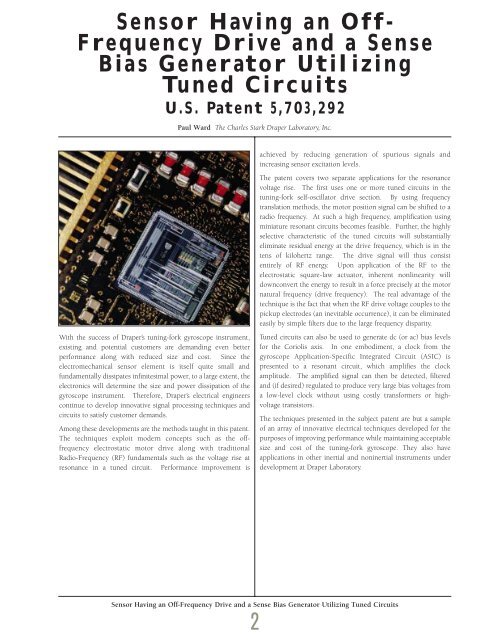1998 - Draper Laboratory
1998 - Draper Laboratory
1998 - Draper Laboratory
- No tags were found...
You also want an ePaper? Increase the reach of your titles
YUMPU automatically turns print PDFs into web optimized ePapers that Google loves.
Sensor Having an Off-Frequency Drive and a SenseBias Generator UtilizingTuned CircuitsU.S. Patent 5,703,292Paul Ward The Charles Stark <strong>Draper</strong> <strong>Laboratory</strong>, Inc.achieved by reducing generation of spurious signals andincreasing sensor excitation levels.The patent covers two separate applications for the resonancevoltage rise. The first uses one or more tuned circuits in thetuning-fork self-oscillator drive section. By using frequencytranslation methods, the motor position signal can be shifted to aradio frequency. At such a high frequency, amplification usingminiature resonant circuits becomes feasible. Further, the highlyselective characteristic of the tuned circuits will substantiallyeliminate residual energy at the drive frequency, which is in thetens of kilohertz range. The drive signal will thus consistentirely of RF energy. Upon application of the RF to theelectrostatic square-law actuator, inherent nonlinearity willdownconvert the energy to result in a force precisely at the motornatural frequency (drive frequency). The real advantage of thetechnique is the fact that when the RF drive voltage couples to thepickup electrodes (an inevitable occurrence), it can be eliminatedeasily by simple filters due to the large frequency disparity.With the success of <strong>Draper</strong>’s tuning-fork gyroscope instrument,existing and potential customers are demanding even betterperformance along with reduced size and cost. Since theelectromechanical sensor element is itself quite small andfundamentally dissipates infinitesimal power, to a large extent, theelectronics will determine the size and power dissipation of thegyroscope instrument. Therefore, <strong>Draper</strong>’s electrical engineerscontinue to develop innovative signal processing techniques andcircuits to satisfy customer demands.Among these developments are the methods taught in this patent.The techniques exploit modern concepts such as the offfrequencyelectrostatic motor drive along with traditionalRadio-Frequency (RF) fundamentals such as the voltage rise atresonance in a tuned circuit. Performance improvement isTuned circuits can also be used to generate dc (or ac) bias levelsfor the Coriolis axis. In one embodiment, a clock from thegyroscope Application-Specific Integrated Circuit (ASIC) ispresented to a resonant circuit, which amplifies the clockamplitude. The amplified signal can then be detected, filteredand (if desired) regulated to produce very large bias voltages froma low-level clock without using costly transformers or highvoltagetransistors.The techniques presented in the subject patent are but a sampleof an array of innovative electrical techniques developed for thepurposes of improving performance while maintaining acceptablesize and cost of the tuning-fork gyroscope. They also haveapplications in other inertial and noninertial instruments underdevelopment at <strong>Draper</strong> <strong>Laboratory</strong>.Sensor Having an Off-Frequency Drive and a Sense Bias Generator Utilizing Tuned Circuits2
















